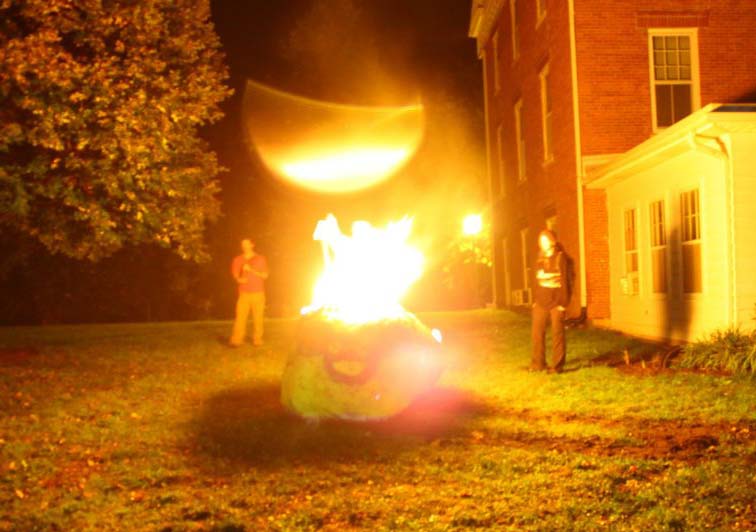Wanderings of The Rock
In 1889 a 5,000-pound boulder, hauled six miles on a horse-drawn wagon from The Pal by members of the senior class, came to rest in front of South Hall. The seniors carved their class year into the granite and left with satisfaction at the permanence of their self-tribute.
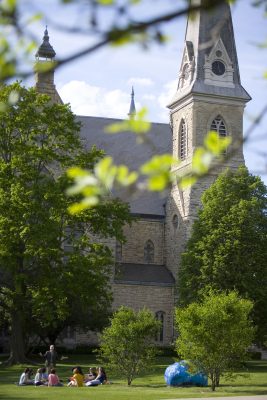
They had created one of Cornell’s oldest traditions. But its location was not to be permanent. Moving The Rock, in addition to painting, burning, and stealing it, is a tradition that unites Cornellians from that day until now. The Rock may be a symbol of permanence and indestructibility, but Cornell students of all eras are nothing if not up to the challenge of moving the unmovable. Here are some stories of The Rock, many of which take place under cover of darkness.
Raymond Reitzel, Class of 1912, left this account of the difficulty involved in unearthing The Rock before the advent of machinery.
When I was a sophomore, the senior class of 1910 buried The Rock completely out of sight. Two years later when I was a senior, I, my roommate, [Raymond] Bradley, and three other classmen, resurrected The Rock. Our first move was to engage a team of horses and a block and tackle with a long rope. About midnight we broke all the light bulbs surrounding the area. We next dug a six-foot incline to the bottom of The Rock, and then made a small tunnel under The Rock and up the backside. Then a loop of rope was passed under The Rock and up the back to the top of The Rock. The ends of this loop of rope were fastened to trees. Another rope was tied to the loop above The Rock to which the team was hitched. The horses pulling on this rope rolled The Rock up the incline. We stopped the horses at intervals in order to place cordwood under The Rock and shovel in dirt. A succession of hitches in this fashion got The Rock on top of the ground. By five o’clock in the morning we had everything in shape and our class number ’12 painted on it.
From “Cornell College: 150 Years from A-Z” by Charles Milhauser
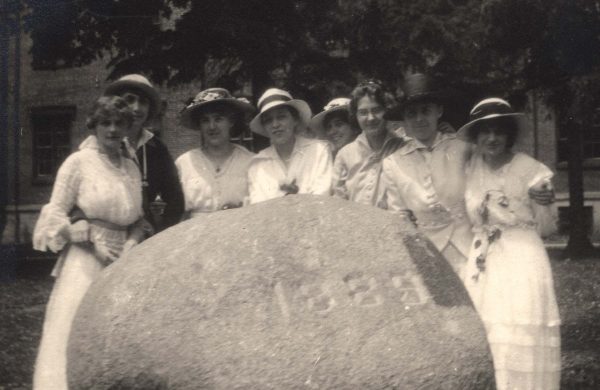
My memory of this event from 65-plus years ago is a bit fuzzy. A group of us dug out The Rock with shovels. I was one of the diggers. It was very late at night. The Rock was in the east part of campus. Whoever organized the event contracted with a towing firm to move The Rock. The owner came with a rig that was too small. He went back to Cedar Rapids and got his big rig, picked up The Rock, and placed it between Old Sem and the Chapel. The group then sang a version of “Rock Of Ages” to the women in Rood House. I think the group was made up of some AXEs, some Owls, and others.
~Richard D. Nelson ’52
The Rock was always being painted by the Owls and the AXEs and the Gammas, and we [the Delts] just decided we were going to bury The Rock. It was the spring of ’54 and we started digging late in the evening, about 11 o’clock. There was a night watchman and we knew his schedule. All we did was make sure that we had our eye out and he never saw us. We dug down and hit a water pipe that led to the chapel, and we realized that we couldn’t drop it in there. One of our guys was in the hole, and about that time I saw the thing starting to slide and I yelled, “Get him out!” We grabbed him and pulled him out of there. The Rock stayed on the edge. Later the AXEs rented some heavy equipment and got The Rock off-campus before the night watchman saw them. We admired the heck out of them because they stole The Rock. They returned it down to the Fieldhouse, by the football concession stand. And then it was moved up on campus by, we think, the maintenance department.
~Bob Majors ’57
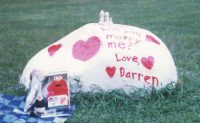
I lived in Bowman Hall with a window facing toward the back side of the chapel. It was not quite dawn, still a bit dark, but I could see the pavement below. I awoke and heard singing, which I soon recognized as “Rock of Ages.” Looking out the window I could not see anyone. I woke up my roommate and she heard the singing too. I said, “Do you suppose we are dead and that is angels singing?” She did not think so, and soon we saw a large group of men strolling along the pavement singing. It turned out they had gotten a crane from the railroad and excavated The Rock from its burial place near Main (College) Hall and moved it near the front of the Chapel. We were freshmen and not too educated yet.
~Dorothea Hinze Herman ’55
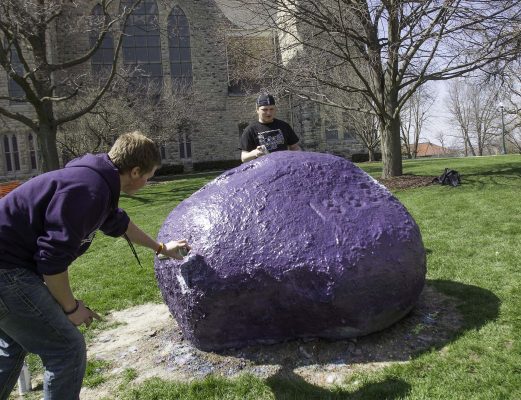
Pledge week is the traditional time when Cornell’s Greek groups show their colors. On campus, the traditional spot for doing so is The Rock. During pledge week spring 1971, The Rock (then located west of Bowman near The Commons) was the scene of intense skirmishes among the pledges charged with having The Rock painted their group’s colors at 8 a.m., when students passed by on their way to class. The pledge who prevailed received special dispensation from his pledge master; the pledges who did not supposedly were punished. I was an Owl. Our colors were black and white. On the first day of pledge week I woke up early. Dutifully went to The Rock. Painted it black. Then, job done, went to breakfast. After which I headed to class. Walking by The Rock, just before 8 a.m., I was shocked to find it painted red, not black. The second day I dutifully painted it black, only to have someone paint it brown. That night, distraught about my wasted time and money, I considered what to do on day three. I thought about how The Rock was covered by years and years of paint. Thoughts about the flammability of paint led me to hatch a plan. The next morning, again up early, I stood by The Rock while a rival pledge painted it red. Then another one painted it brown, and yet another one painted it yellow. One minute before 8 I stepped up to The Rock. Splashed it with gasoline. Lit a match. Tossed it on the gas. Voila, The Rock turned black. Problem solved. I headed to class. Dispensation received. Reputation established. I was henceforth known as Torch. A name that to this day I am still called.
~Mark Weston ’74
The Rock had been embedded near Bowman, in front of The Commons, for a number of years, so in the spring 1971 we dug it up with shovels from the geology department (how many college students have shovels in their dorm rooms?). Sylvia Russell ’74 and Liz Henriksen ’74 were in on the shovel borrowing, and Nan Caldwell Spatz ’74 and others joined them on the digging. There may have been others in on the digging and the drama. My apologies for not remembering off the top of my gray head!
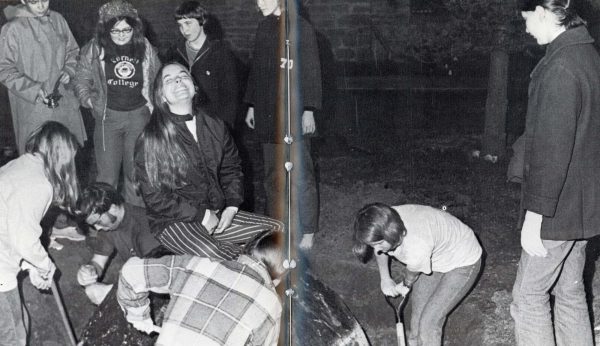
We had no idea it was that BIG. Only the top quarter of The Rock was above ground then, and it didn’t take nearly as much paint as now. I passed the hat for the $30 for the tow truck. The security men were quite upset with us. They didn’t know what to do with these coeds who were digging up Cornell real estate. They woke up [Buildings and Grounds Superintendent] Cecil Thomas, who reflected with horror at the suggestion of it being rolled into Ink Pond. He said there were metal mesh and pipes under the pond that would be crushed. He woke up [Vice President for Business Affairs] Charlie Cochrane, who showed up in his pajamas under a trench coat and was a bit more sanguine than Cecil Thomas.
When we finally got down to the base of The Rock, I called the tow truck operators. They had gotten a call telling them that we had decided not to move it. Once they got there and The Rock was up in the air, a controversy arose about where it could be placed, as the truck and Rock were deemed a hazard to the infrastructure of the Mall. We had wanted to move it close to where it is now [near the Ped Mall and Old Sem]. We were basically told that it could go on the lawn between the Carnegie Library and College Hall, not at all central to the foot traffic of the campus life. It ended up between the street and College Hall, near the sundial.
We paid extra for the tow truck, as the meter was running. I probably gave up soda pop for the remainder of the term.
~Marta Wherry Mathatas ’74
In the spring of 1977, I was walking back to my dorm from the old painting studio building. It had to have been close to 1 or 2 a.m. Going to the residence hall took me near The Rock, which was situated right next to the drop-off circle behind King Chapel.

Out of the corner of my eye, I noticed several people standing around it. Ordinarily, I would not have given the activity a second thought because it was never out of the ordinary to see The Rock being updated at any hour, day or night. What caught my attention and drew me over were the voices I recognized as belonging to fellow Altoonians (a story for another time!). Of course I had to see what they were up to. It didn’t take long to see they were well along in their digging of a very large hole. They invited me to join in, but a little sleep beckoned. I laughed, wished them luck, and went on my way. Sure enough, the next morning, there was nothing but a bare spot where The Rock had been. Rumors abounded, but the secret was kept. I graduated, stayed around for awhile, then moved home the next year. Someone else will have to confirm who solved the puzzle and when, but I know it was still a mystery when I left Mount Vernon. I will also leave it to others to name those present—I’ll never tell.
Addendum: Discussion on the Facebook group Men of Altoona 1974-1977 revealed that part of the original plan was to have The Rock exhumed Easter Sunday morning. To which another Altoonian responded: “With new paint that said, ‘I am the rock?'”
~Jeff Courtman ’77

I recall, during my junior or senior year (1977/1978) when The Rock appeared to have simply disappeared. There was much speculation as to where it had gone, who did it, and how it had been accomplished. As it turned out, a group of students (rumored the Owls) had buried it, on site. Needless to say, it took more effort to lift it from its “burial” than it took to roll it in. The Rock was located across the path from Allee Chapel, between Bowman and King Chapel. The great thing about the prank was that it was buried right where it sat, and no one thought to look there.
~Harlan Newell ’78
Freshman year 1983-84: One evening my roommate, Jackie Fallon ’87, and I were walking back to Dows Hall from the library. Suddenly, from somewhere in the tri-dorm courtyard, an unidentifiable male figure sharply ordered, “Stay away from The Rock!” In those days, as I believe it is currently, The Rock was residing near King Chapel, so we immediately veered to the left behind Tarr Hall, looking over our shoulders as we detoured. Within seconds,
“…there was a flash and an explosion coming from under the boulder—”
and a “WHOOP!” from several voices in the courtyard. Upon examination the next morning, it was evident that The Rock had remained unharmed.
~Joanne Vest ’87
Relocation of The Rock to the AXE Farm—1992 [from the AXE archives]
After [name removed] caught himself on fire during one particularly enthusiastic rock burning in 1991, the administration started to crack down on our generous public service to the Cornell community in the form of free removal of paint buildup on The Rock. Although [name removed] was uninjured due to the heroic efforts of his brothers who quickly extinguished him, the college seized the opportunity to start limiting this time-honored tradition. It began with the requirement that we contact security 24 hours in advance so that one of them could be on hand with a fire extinguisher in the event that someone burst into flames. During this period of AXE history, rock burning occurred in association with several distinct scheduled events, as well as at various unscheduled times. Scheduled events included: 1) at twilight the first Monday of class; 2) Friday night of Homecoming; and 3) every night of pledging except Saturday.
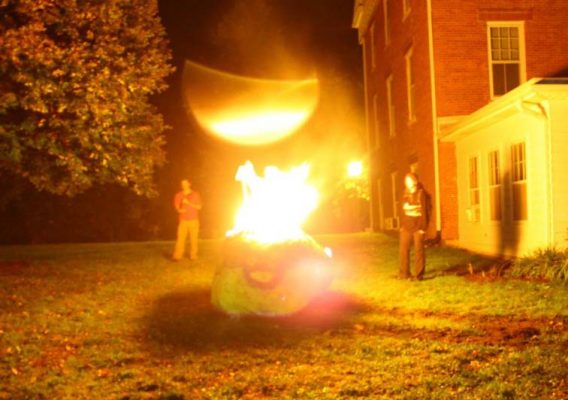
… for obvious reasons the need to, in essence, get permission every time we wanted or needed to burn “our” rock was completely unacceptable. We offered an olive branch to the college in the form of providing a fire extinguisher at all rock burnings … By the end of 1992 rock burning was nearly impossible without a note from God that was cosigned by his mother, and if it happened, it usually involved a $100 fine for “damage” to the grass.
While I am not sure if it was the cause of his heroism, [name removed] and I had a conversation about The Rock issue in the days just prior to my returning home following graduation. [Name removed] asked me what they should do about the situation for the future. My advice to him was to “take the damn thing to the farm so you can burn it five times a day if you want to … it is, after all, our rock.” I thought nothing of it until I came back for AXEtoberfest in the autumn of ’92 … Upon my arrival at the farm, I received a warm greeting from the boys and when [name removed] came up to shake my hand, he laughed and pointed to the pasture and said, “How do you like our new addition to the farm?” Looking out I saw The Rock in all its glory, charred completely black except for a shiny red AXE crest. The number of times I have been proud of the group and proud to have been allowed to be a part of it are too many to count, but that day was one of the proudest.
The Rock remained at the farm until the fall of ’94, when the college realized we intended to keep it. Homecoming was coming up … and the administration wanted it … Recognizing their panic, we arranged for the safe return of The Rock to campus for the price of a wrecker service. Most importantly, [name removed] required a promise that The Rock could be burnt without restriction for as long as it remained on campus.
~Eric Ewert ’92
(submitted by Frankie Najera ’07)
I remember hearing during my campus tour that anyone could paint The Rock and that in the past, different groups would move The Rock or even steal it. I always thought it was an interesting tidbit, but it wasn’t until my second semester when I joined Alpha Chi Epsilon (AXE) when I learned more about The Rock and it became part of my college life.

As an AXE we had the tradition and the administration’s approval to burn The Rock during pledging and special events. It was always great to clean up The Rock after it had been painted over again and again. I can’t count the number of times it was burned during my four years at Cornell, but I loved each one. The AXEs often talked about moving The Rock around campus or even out to our farm as our alumni had once done back in the ’90s. We never did move it in my years at Cornell, but another group, I believe it was the Newts or Delts, moved The Rock with a small skid loader, but in a panic left it right next to a small tree at the administration building. Where they left The Rock eliminated the potential of burning of The Rock for the rest of my senior year. I graduated and moved on from Cornell, but I would always remember how unfortunate that The Rock could no longer be burned.
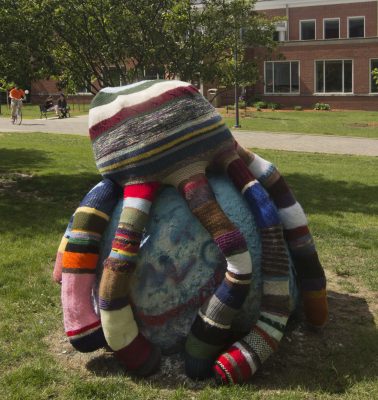
Fast forward to 2011 when I started traveling across the country and would often make sure to stay a night or two in Mount Vernon in my travels and show my friends my old stomping grounds. During this time I was big into slacklining and during an evening it occurred to me I could use my slackline gear to move The Rock back into a favorable position for burning. We got together some current actives, alumni, and friends and set out to campus to make this happen. After about 30 minutes to an hour, we managed to move The Rock about 30-40 feet back into the open. What was a bit crazy to me was that we did this at maybe 8 or 9 p.m. and there were plenty of students roaming about and in the library, but I don’t think they realized what was happening or just brushed it off as something that would not happen.
As soon as we moved it, we gathered our gear, covered it in gas, and set it ablaze. As far as I am aware, The Rock still is in the spot where we left it. I’m proud to say that we did not use any sort of power equipment to move The Rock, but simply muscle.
~Frankie Najera ’07
WEB EXTRA: See video of Frankie Najera ’07 and others burning The Rock in 2011 after their move.

